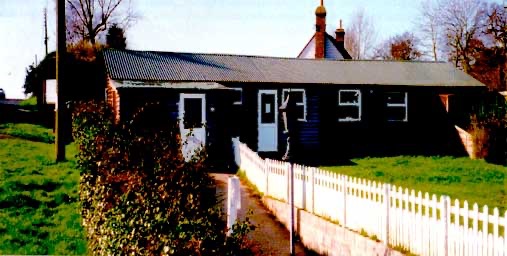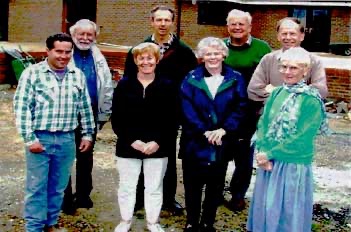History


The Old Bodle Street Green Village Hall
Nobody seems quite certain when the old Bodle Street Green Village Hall was erected, but it was probably towards the end of I923. But we do have an undated newspaper cutting describing the original public meeting at the school: “The inhabitants of Bodle Street Green are to provide themselves with a village hall”. The meeting was presided over by the Rector, The Revd. David Bethell (1920 – 1924)
Almost everyone was in favour. Mr. G W Barnes (son of George Barnes, founder of the agricultural engineers} volunteered to give the site. (The formal conveyance is dated 19th December 1923). Mr. Charles Keeley (Toll Farm, and Margaret Holt’s Grandfather) then announced that he had purchased an ex-army hut for £40 and he was prepared to subscribe £25 towards the cost. Squire Matthey (Bucksteep Manor) also volunteered £25, and another £43.5s was promised that evening. Four collectors and a Committee were appointed.
The late Bunny Unsted recalled the hut being collected by wagon from Hellingly Station, on the now defunct Cuckoo Line, and willing helpers erected it.
Once in place, it made a tremendous difference to village life. Generally people had more leisure activities. Concerts were organised, and social evenings, dances and whist drives. The late Fred Creasey remembered that there were so many tables at the whist drives that in order to change places you had to exit by the kitchen and re-enter by the main door. Dances were held on alternate Saturdays with those at the Dunn Hall, Rushlake Green, the music being supplied by a three-man band – piano, drums and a violin. An undated press cutting describes a social evening arranged by the ladies’ and gentlemen’s committees which was attended by 150 (the fire regulations wouldn’t stand for that now). “There was a programme of songs and recitations, and musical selections were played on the gramophone”. Mrs. Young (Redpale Farm) read a paper “Is Music Beneficial to Cattle?”
In l923 the Women’s‘ Institute (always called “The Institute “) was formed. It met on the second Tuesday afternoon of the month for 75 years. A press cutting refers to a WI meeting at which Captain Gardiner (Summertrees) “gave a most interesting talk on his life in India”. Mr. Rogers of Windmill Hill, who gave a demonstration of how to make slippers out of an old felt hat, followed him. For the younger people in the village, the hall was partitioned on most weekday evenings. The main part – with billiard table – was for billiards, darts, and table tennis, while the smaller section at the back was for the girls to do needlework and knitting. A half crown subscription covered this. (the billiard table survived into the 70’s, when it seemed to be taking up an awful lot of space and was sold for £10.}
The dances continued during the Second World War and were enlivened by the arrival of the Canadians billeted at Trumpets Farm and the local land girls. Several Bodle Street girls became Canadian army brides. The WVS also met in the hall to practice first aid under the direction of Mrs. Gardiner and Mrs. Dunn (Stone House, Rushlake Green)
For a long time after the war all the events at the hall were local ones. The Wl ran Christmas parties for the children; there were amateur dramatics, and dances to celebrate big days like the Coronation. There was never a proper stage until I959 when the school closed. Later on, the annual harvest suppers began. The Gardening Club was started when local groups were invited to a meeting and each gave a small sum to start off. The first Flower Show was held in l959. A public library was held fortnightly in the hall; the books were stored in boxes under the billiard table and behind grills along the wall. The Playgroup started in the 80’s.
Mains water didn‘t reach Bodle Street until after the war, and buckets of water for the Hall had to be drawn from the well at Mill House. There were, of course, bucket toilets in the loo.
As for heating, there was an open wood fire in the kitchen on which the kettle or the urn was heated. The main heat in the hall came from a slow combustion stove which burned coke. This was replaced by a couple of Courtier stoves from the school after it closed, and more recently, Calor gas stoves.
Lois Beale and her late husband, Tom, took on the job of caretaking in 1933, and together with their son Ernie, have put in 65 years‘ service this year.
Ruth Ayres – August 1998.
All Change
In I993 after much debate, it was decided to raise money to build a new Hall. The old Hall had structural weaknesses which put it beyond economic repair, and it could no longer be adapted to meet modem environmental legislation. The task of raising the very considerable amount of money required seemed daunting, but a wide range of fund-raising activities was soon under way. Over130,000 was raised locally during the next five years. In 1997, the award of grants by Wealden District Council and the Rural Development Commission meant that sufficient funds were available to go ahead with the building of a new Hall.
Demolition of the old Hall was scheduled for the first week in April of I998, however at the final event on 27th March I998, the Chairman of the Management Committee, Jim Petrides, was able to announce (see picture) the award of a grant from the National Lottery Charities Board which completed all the funding required. The new building could now be fully equipped to meet all the requirements of the regular users of the Hall. What had seemed impossible for so long was now about to become a reality.
The New Bodle Street Green Village Hall
ln 1995, the Management Committee decided to obtain planning consent for a new Hall and also to draw up detailed plans. The old Hall occupied almost all of the land originally donated in 1923. In 1991, some of the land adjoining the Hall on the north side and which formed part of the agricultural works, was donated to the Trust to provide a small recreational area and a car park. In 1994, Mrs. Margery Smith and her daughter, Mrs. Caroline Roots, donated additional land to the west of the car park. The new Hall could, therefore, be somewhat larger and sited in a slightly different position.
The Committee appointed as architect, Mr. Kenneth Higgs, who had designed Halls in Cooden and Eastbourne, but it took almost two years to finalise the plans and to obtain all the necessary consents. The position and layout of the new Hall underwent many changes as the Committee tried to incorporate all the requirements of local organisations and also to meet the concerns of local residents. Early in I997, several local builders were invited to tender for the building even though funding was not yet available This enabled the Committee to have a very clear idea of the costs which would be involved and the tenders proved to be invaluable when submissions were made for grants to the Rural Development Commission and to the National Lottery Charities Board,
At the end of March 1998, A J Hammonds (Builders) Ltd, of Little Common, Bexhill, were awarded the contract and they started work clearing the site on 13th April. By this time Kenneth Higgs had incorporated his practice into Nigel Faulkner Associates, also of Bexhill, who now became the architects for the new Hall A project team of Jim Petrides, Philippa & Richard Gentry, Mary & Bryan Gibson and Margaret & Geoff Holt acted on behalf of the Management Committee in liaising with the architect and the builder. Meeting several times a month, the Project Team made decisions on major items such as the “floating” floor in the main hall and the layout of the kitchen, as well as the myriad of smaller details such as light fittings, floor coverings, door knobs, baby changing table and soap dispensers. Away from the site, the team spent many happy hours choosing the stage, chairs, curtains and blinds, tiles and kitchen appliances. As all decisions were unanimous, hopefully the final result will meet with general approval. When the plans were being drawn up, all the regular users of the old Hall were invited to list the facilities they would like to see in the new building. No one ever imagined that all the items on the “wish list“ would be able to be incorporated during the initial build, but the award of the various grants made this possible. The plans always allowed for access by, and facilities for, those with disabilities. A hearing loop for the aurally challenged has also been incorporated. The staging, chairs and tables have been chosen to give maximum flexibility, with all the lights being controlled by dimmers to provide a wide range of illumination. Outside, there is an extended patio area, a recreational area which has yet to be landscaped and a good sized car park. However every effort has been made to try and retain the friendly and welcoming atmosphere which was such a feature of the old hall. For those who knew and loved the old hall, the new Hall with all its new fixtures and fittings may take some getting used to but hopefully everyone will soon feel at home.
The old and the new Bodle Street Green Village Hall have one thing in common: neither would have been possible without the whole-hearted support of the residents of Bodle Street Green. In I923, probably no one envisaged a World War I army hut surviving for 75 years and becoming so firmly established at the centre of village life. The new Hall should serve the village for even longer, and all those who have helped to make it happen can feel pride that a great village tradition is being continued. And hence almost exactly 75 years after our story began we reach the end of this chapter with the official opening of the new Hall on l0th October 1998 by Admiral Sir Lindsay Bryson KCB FEng, Lord Lieutenant of East Sussex and Vice President of the Sussex Rural Community Council.
Chairmen
Charles Keeley Snr. (1923 – 1946);
Mrs. Curtis (1947 – 1950);
Mr. G A Perry (1950 – 1953);
Mr. Lawrence Saunders (1953 – 1984);
Mr. Peter Saunders (1984 – 1990);
Mr. James B Petrides (1991 – 1999);
Mr. Richard Gentry (1999 – 2006);
Mr. Barrie Cooper (2007 – 2010);
Mr. Hans Petri (2011 – 2013);
Mr. Charles Harding (2013 to date)
Village Hall Presidents
Captain C Gardiner (1948 – 1960)
Mr. Michael M Harding (1960 – 1979)
Commander Bryan D Gibson MBE Royal Navy ( 2024 - present)
Trustees
Percy St.C Matthey (Bucksteep Manor) (19/12/23 – 14/04/28);
Charles Keeley (Toll/Farm) (19/12/23 – 14/09/49);
Thomas M Dalziel (TwizhurstlHole Farm) (19/12/23 – 21/06/32);
Charles F Gardner (Summertrees) (17/01/39 – 07/11/63);
Cecil W V Peake (Iwizhurst) (17/01/39 – 20/03/50);
Frank Roberts (The Stores) (20/03/50 – 18/09/55);
Rev. John C Hart (Ninfield) (20/03/50 – 16/08/54);
Michael M Harding (Hole Farm) (16/08/54 – 25/02/79);
Lawrence Saunders (CausewayCottage) (28/01/56 – 24/01/94);
James B Petrides (Attwood Farm) (28/05/80 – 31/12/07);
Richard E Gentry (Stud Farm) (28/05/80 – 5/08/06);
Lindsay Godwin (1/1/08 – 26/4/18);
Barrie D Cooper (28/05/80 - );
Philippa Gentry (1/1/08 –);
Bryan D Gibson MBE (1/1/08 –)